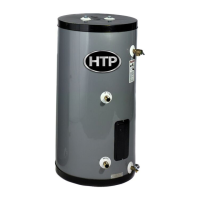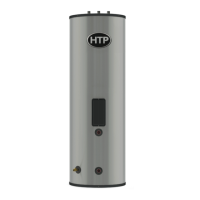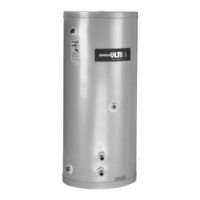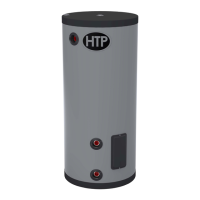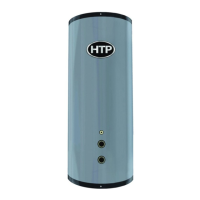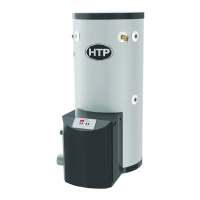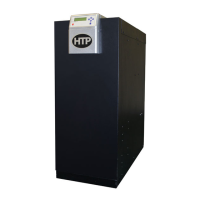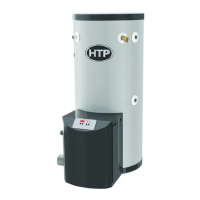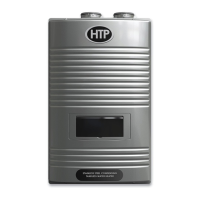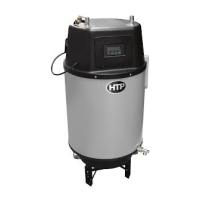lp-65 Rev. 002 Rel. 010 Date 10.11.19
5
D. Water Chemistry Requirements
Chemical imbalance of the water supply may aect eciency
and cause severe damage to the water heater and associated
equipment. HTP recommends having water quality professionally
analyzed to determine whether it is necessary to install a water
softener. It is important that the water chemistry on both the
domestic hot water and central heating sides are checked before
installing the water heater, as water quality will aect the reliability
of the system. In addition, operating temperatures above 135
o
F
will further accelerate the build-up of lime scale and may shorten
the service life of the water heater. Failure of a water heater due to
lime scale build-up, low pH, or other chemical imbalance IS NOT
covered by the warranty.
The water must be potable, free of corrosive chemicals, sand,
dirt, and other contaminates. It is up to the installer to ensure the
water does not contain corrosive chemicals or elements that can
damage the heat exchanger. Potable water is dened as drinkable
water supplied from utility or well water in compliance with EPA
secondary maximum contaminant levels (40 CFR Part 143.3). If
the water contains contaminants higher than outlined by the EPA,
water treatment is recommended and additional, more frequent
maintenance may be required.
If you suspect that your water is contaminated in any way,
discontinue use of the water heater and contact an authorized
technician or licensed professional.
• Water pH between 6.5 and 8.5
• pH levels below 6.5 can cause an increase in the rate of
corrosion. pH of 8.5 or higher can potentially cause lime
scale build-up
• Maintain water pH between 6.5 and 8.5. Check with litmus
paper or have it chemically analyzed by a local water
treatment company.
• If the pH is not between 6.5 and 8.5, consult a local water
treatment company for solutions.
• Hardness less than 12 grains (200 mg/L) (Residential Use
- water temperatures below 140
o
F)
• Hardness less than 7 grains (120 mg/L) (Commercial Use
- water temperatures of 140
o
F and greater)
• Hardness levels above the required amounts can lead to
lime scale build-up throughout the system. Water below 5
grains/gallon (85 mg/L) may be over softened.
• Consult local water treatment companies for unusually
hard water areas (above the required amounts) or for
other treatment solutions if water is being over softened
(below 5 grains/gallon [85 mg/L]).
• Chloride concentration less than 100 ppm (mg/L)
• Do not ll water heater or operate with water containing
chlorides in excess of 100 ppm (mg/L).
• Using chlorinated fresh water should be acceptable as
levels are typically less than 5 ppm (mg/L).
• Do not connect the water heater to directly heat swimming
pool or spa water.
• Total Dissolved Solids (TDS) less than 500 ppm (mg/L)
• Total dissolved solids are minerals, salts, metals, and
charged particles that are dissolved in water.
• The greater the amounts of TDS present, the higher the
corrosion potential due to increased conductivity in the
water.
• If using softened water to ll the water heater, it is still
possible to have high TDS. This water can be corrosive.
Consult local water treatment companies for other
treatment solutions to reduce this aect.
*NOTE: To promote water heater service life, it is strongly recommended
to follow the maintenance procedures in this manual.
Part 3 - Piping
A. Plumbing
It is mandatory that all plumbing be done in accordance with federal,
local, and state plumbing codes and practices. Failure to properly
install the water heater WILL VOID the warranty. It is also necessary
to use both thread tape and pipe dope on all mechanical plumbing
connections.
When lling the water heater, open a hot water tap to release air in
the tank and piping. Failure to do so could lead to improper water
heater operation and damage to components.
B. Boiler Connections
Use two wrenches when tightening water piping at the heater. Use
one wrench to prevent the heater return or supply line from turning.
Failure to prevent piping connections from turning could cause
damage to water heater components.
Use a 1” nominal minimum pipe size when piping with zone valves or
circulators.
On the water heater, the boiler supply connects to the outlet of the
circulator. The circulator inlet is to be connected to the hot outlet
side of the boiler. Be sure that the arrow on the circulator is facing
the correct ow direction. (See pressure drop sizing for circulator, this
manual.) On the tank, the boiler return connects to the return side of
the boiler. The return(s) from heating loop(s) should have a ow check
or swing check valve installed before the return pipe from the tank.
In a steam boiler, the tank supply must be connected to the boiiler well
below the minimum water level. A strainer and drain valve should be
installed at the boiler for periodic draining of scale and sludge. Banging
and steam bound traps will occur if the boiler water supplied to the
heat exchanger has steam or is slightly above the low water cut-o.
The water heater heat exchanger cannot be used with non-barrier
radiant pipe systems. Use with closed loop boiler systems only.
C. Domestic Piping Inlet
Dielectric ttings must be used on water connections.
Use both thread tape and pipe dope to connect an NPT female X 3/4”
(minimum) pipe adapter. A shut-o valve between the city water
supply and tank inlet is recommended for ease of service.
It may be recommended to use a back ow preventer - check local
codes. If a back ow preventer or a no return valve is used, a thermal
expansion tank must be installed on the cold water supply between
the tank and valve. If the tank is replacing a tankless coil in the boiler,
disconnect coil plumbing and use the cold inlet pipe and hot water
outlet pipes for the water heater.
NOTE: DO NOT PLUG OUTLET IN TANKLESS COIL.
Exercise caution when soldering water heater connections, as outlet
and inlet dip tubes are plastic.
D. Hot Water Outlet
Dielectric ttings must be used on water connections.
Exercise caution when soldering water heater connections, as outlet
and inlet dip tubes are plastic.
